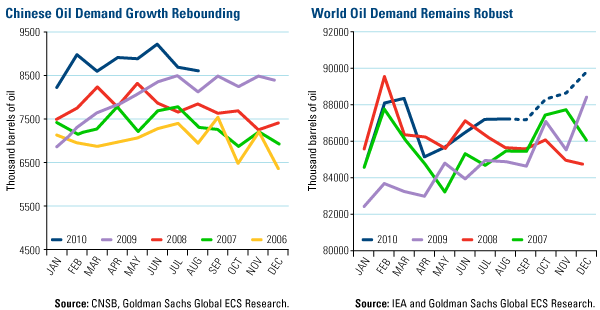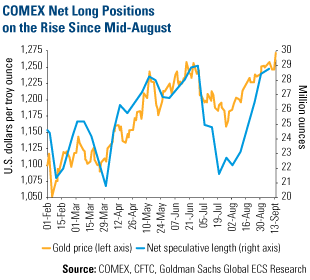It’s been a lively year for both gold and oil investors but the year to remember may be the one ahead.
Goldman Sachs is forecasting a 27 percent jump in energy and a 17 percent rise in precious metals over the next 12 months. On the oil side, Goldman credits a rebound in industrial production for a 520,000-barrel-per-day increase in China’s implied oil demand in August (year over year). As you can see from the left-side chart, Chinese oil demand has remained a fairly consistent story going back several years.

Globally, world oil demand was up 2.4 million barrels per day on a year-over-year basis in August, according to Goldman Sachs (right chart). Rising demand from emerging nations has created a 600,000-barrel-per-day global supply deficit since May. This month saw a reversal in the U.S., with weeks of growing inventory surpluses swinging to draw-downs after Labor Day.
The long-term prospects for oil haven’t changed. Estimates from Wood Mackenzie and Deutsche Bank show that global oil production will decline 12 percent by 2015 without new investment. Production rates in Britain, Australia, U.S. offshore and Norway have declined 15 percent or more since 2000. Finding future reserves is increasingly difficult and costly, so prices will have to be higher to make developing these reserves worthwhile.
 New all-time high prices for gold this week leave many to wonder if we’re nearing a top, but we think gold’s bull run may have further to go. Since mid-August, prices have risen on the back of a significant increase in net long positions on the COMEX and investor interest is near highs for the year. In addition, central bankers have also been stocking up on gold—for the first time since 1988, they will be net buyers of bullion in 2010.
New all-time high prices for gold this week leave many to wonder if we’re nearing a top, but we think gold’s bull run may have further to go. Since mid-August, prices have risen on the back of a significant increase in net long positions on the COMEX and investor interest is near highs for the year. In addition, central bankers have also been stocking up on gold—for the first time since 1988, they will be net buyers of bullion in 2010.
This could also be just the beginning. BCA Research says gold is in a bull market and will “remain that way until macro and/or industry-specific trends change significantly. BCA cites low real interest rates and high policy uncertainty as the twin engines powering gold higher.
Washington has yet to show how it will reduce the gaping federal deficit, and the Federal Reserve is expected to keep interest rates near zero well into 2011. When you throw in a possible return to quantitative easing, the prospects for higher gold prices look even stronger.
The sturdiest pillar supporting both gold and oil should continue to be China. Even though China was recently crowned the world’s largest energy consumer, the country’s energy demands are still small on a per-capita basis. And for gold, Chinese demand—government, investor and jewelry consumers—remains strong despite high prices. The World Gold Council predicts gold consumption there could double in the coming decade.
Fears of a bubble bursting in the Chinese economy have been deflated as the country prepares itself for a soft landing. Analysts at CLSA says China will remain “the world’s best consumption story; due to income growth, moderate inflation and low household debt. They expect GDP growth to be just under 10 percent this year, and 8 percent to 9 percent in 2011.
There will likely be short-term volatility in commodities, but we believe the enduring strength of the global growth story being led by China and other key emerging markets should be a powerful demand driver in the years ahead.
If you haven’t already had a chance, I invite you to read The Case for Gold.
The COMEX is a commodity exchange in New York City formed by the merger of four past exchanges. The exchange trades futures in sugar, coffee, petroleum, metals and financial instruments.
- Bulenox: Get 45% to 91% OFF ... Use Discount Code: UNO
- Risk Our Money Not Yours | Get 50% to 90% OFF ... Use Discount Code: MMBVBKSM
Disclaimer: This page contains affiliate links. If you choose to make a purchase after clicking a link, we may receive a commission at no additional cost to you. Thank you for your support!




Leave a Reply